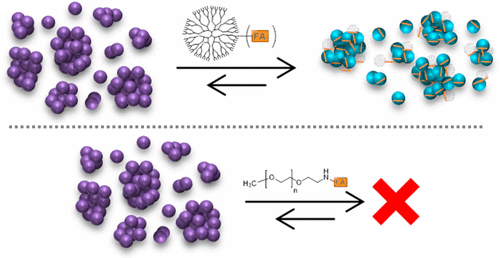当前位置:
X-MOL 学术
›
Bioconjugate Chem.
›
论文详情
Our official English website, www.x-mol.net, welcomes your feedback! (Note: you will need to create a separate account there.)
Conjugation Dependent Interaction of Folic Acid with Folate Binding Protein
Bioconjugate Chemistry ( IF 4.7 ) Pub Date : 2017-08-09 00:00:00 , DOI: 10.1021/acs.bioconjchem.7b00373 Rachel L. Merzel , Carolina Frey , Junjie Chen , Rachel Garn , Mallory van Dongen , Casey A. Dougherty , Ananda Kumar Kandaluru 1 , Philip S. Low 1 , E. Neil G. Marsh , Mark M. Banaszak Holl
Bioconjugate Chemistry ( IF 4.7 ) Pub Date : 2017-08-09 00:00:00 , DOI: 10.1021/acs.bioconjchem.7b00373 Rachel L. Merzel , Carolina Frey , Junjie Chen , Rachel Garn , Mallory van Dongen , Casey A. Dougherty , Ananda Kumar Kandaluru 1 , Philip S. Low 1 , E. Neil G. Marsh , Mark M. Banaszak Holl
Affiliation

|
Serum proteins play a critical role in the transport, uptake, and efficacy of targeted drug therapies, and here we investigate the interactions between folic acid–polymer conjugates and serum folate binding protein (FBP), the soluble form of the cellular membrane-bound folate receptor. We demonstrate that both choice of polymer and method of ligand conjugation affect the interactions between folic acid–polymer conjugates and serum FBP, resulting in changes in the folic acid-induced protein aggregation process. We have previously demonstrated that individual FBP molecules self-aggregate into nanoparticles at physiological concentrations. When poly(amidoamine) dendrimer–folic acid conjugates bound to FBP, the distribution of nanoparticles was preserved. However, the dendritic conjugates produced larger nanoparticles than those formed in the presence of physiologically normal human levels of folic acid, and the conjugation method affected particle size distribution. In contrast, poly(ethylene glycol)–folic acid conjugates demonstrated substantially reduced binding to FBP, did not cause folic acid-induced aggregation, and fully disrupted FBP self-aggregation. On the basis of these results, we discuss the potential implications for biodistribution, trafficking, and therapeutic efficacy of targeted nanoscale therapeutics, especially considering the widespread clinical use of poly(ethylene glycol) conjugates. We highlight the importance of considering specific serum protein interactions in the rational design of similar nanocarrier systems. Our results suggest that prebinding therapeutic nanocarriers to serum FBP may allow folate-specific metabolic pathways to be exploited for delivery while also affording benefits of utilizing an endogenous protein as a vector.
中文翻译:

叶酸与叶酸结合蛋白的结合依赖性相互作用
血清蛋白在靶向药物治疗的转运,摄取和功效中起着关键作用,在这里我们研究叶酸-聚合物结合物与血清叶酸结合蛋白(FBP)(细胞膜结合叶酸的可溶形式)之间的相互作用受体。我们证明,聚合物的选择和配体结合的方法都会影响叶酸-聚合物结合物与血清FBP之间的相互作用,从而导致叶酸诱导的蛋白质聚集过程发生变化。我们以前已经证明,单个FBP分子在生理浓度下会自动聚集成纳米颗粒。当聚(酰胺基胺)树状聚合物-叶酸结合物与FBP结合时,纳米颗粒的分布得以保留。然而,与在人体生理水平正常的叶酸存在下形成的树枝状缀合物相比,树状缀合物产生的纳米粒更大,并且缀合方法影响粒径分布。相反,聚(乙二醇)-叶酸共轭物显示出与FBP的结合力大大降低,没有引起叶酸诱导的聚集,并完全破坏了FBP的自聚集。基于这些结果,我们讨论了靶向纳米级治疗剂对生物分布,运输和治疗功效的潜在影响,特别是考虑到聚乙二醇共轭物的广泛临床应用。我们强调在类似纳米载体系统的合理设计中考虑特定血清蛋白相互作用的重要性。
更新日期:2017-08-09
中文翻译:

叶酸与叶酸结合蛋白的结合依赖性相互作用
血清蛋白在靶向药物治疗的转运,摄取和功效中起着关键作用,在这里我们研究叶酸-聚合物结合物与血清叶酸结合蛋白(FBP)(细胞膜结合叶酸的可溶形式)之间的相互作用受体。我们证明,聚合物的选择和配体结合的方法都会影响叶酸-聚合物结合物与血清FBP之间的相互作用,从而导致叶酸诱导的蛋白质聚集过程发生变化。我们以前已经证明,单个FBP分子在生理浓度下会自动聚集成纳米颗粒。当聚(酰胺基胺)树状聚合物-叶酸结合物与FBP结合时,纳米颗粒的分布得以保留。然而,与在人体生理水平正常的叶酸存在下形成的树枝状缀合物相比,树状缀合物产生的纳米粒更大,并且缀合方法影响粒径分布。相反,聚(乙二醇)-叶酸共轭物显示出与FBP的结合力大大降低,没有引起叶酸诱导的聚集,并完全破坏了FBP的自聚集。基于这些结果,我们讨论了靶向纳米级治疗剂对生物分布,运输和治疗功效的潜在影响,特别是考虑到聚乙二醇共轭物的广泛临床应用。我们强调在类似纳米载体系统的合理设计中考虑特定血清蛋白相互作用的重要性。



























 京公网安备 11010802027423号
京公网安备 11010802027423号